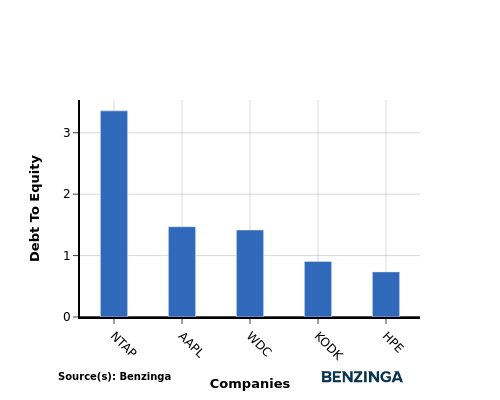Performance Comparison: Apple And Competitors In Technology Hardware, Storage & Peripherals Industry
In today's fast-paced and highly competitive business world, it is crucial for investors and industry followers to conduct comprehensive company evaluations. In this article, we will delve into an extensive industry comparison, evaluating Apple (NASDAQ:AAPL) in relation to its major competitors in the Technology Hardware, Storage & Peripherals industry. By closely examining key financial metrics, market standing, and growth prospects, our objective is to provide valuable insights and highlight company's performance in the industry.
Apple Background
Apple is among the largest companies in the world, with a broad portfolio of hardware and software products targeted at consumers and businesses. Apple's iPhone makes up a majority of the firm sales, and Apple's other products like Mac, iPad, and Watch are designed around the iPhone as the focal point of an expansive software ecosystem. Apple has progressively worked to add new applications, like streaming video, subscription bundles, and augmented reality. The firm designs its own software and semiconductors while working with subcontractors like Foxconn and TSMC to build its products and chips. Slightly less than half of Apple's sales come directly through its flagship stores, with a majority of sales coming indirectly through partnerships and distribution.
| Company | P/E | P/B | P/S | ROE | EBITDA (in billions) | Gross Profit (in billions) | Revenue Growth |
|---|---|---|---|---|---|---|---|
| Apple Inc | 33.40 | 47.94 | 8.14 | 37.11% | $32.25 | $44.87 | 5.08% |
| Super Micro Computer Inc | 27.10 | 4.66 | 1.45 | 1.72% | $0.14 | $0.44 | 19.48% |
| Hewlett Packard Enterprise Co | 19.62 | 1.12 | 0.86 | -4.4% | $0.87 | $2.17 | 5.87% |
| Western Digital Corp | 22.97 | 4.52 | 1.51 | 5.86% | $0.28 | $0.91 | 30.94% |
| NetApp Inc | 18.51 | 20.22 | 3.34 | 33.42% | $0.43 | $1.19 | 3.84% |
| Pure Storage Inc | 146.84 | 14.66 | 5.90 | -1.1% | $0.04 | $0.54 | 12.26% |
| Eastman Kodak Co | 13.90 | 0.96 | 0.57 | -1.66% | $0.02 | $0.05 | -0.8% |
| Turtle Beach Corp | 18.38 | 2.27 | 0.75 | -0.55% | $0.0 | $0.02 | 14.42% |
| Average | 38.19 | 6.92 | 2.05 | 4.76% | $0.25 | $0.76 | 12.29% |
Through a thorough examination of Apple, we can discern the following trends:
-
The stock's Price to Earnings ratio of 33.4 is lower than the industry average by 0.87x, suggesting potential value in the eyes of market participants.
-
With a Price to Book ratio of 47.94, which is 6.93x the industry average, Apple might be considered overvalued in terms of its book value, as it is trading at a higher multiple compared to its industry peers.
-
The Price to Sales ratio of 8.14, which is 3.97x the industry average, suggests the stock could potentially be overvalued in relation to its sales performance compared to its peers.
-
With a Return on Equity (ROE) of 37.11% that is 32.35% above the industry average, it appears that the company exhibits efficient use of equity to generate profits.
-
The company exhibits higher Earnings Before Interest, Taxes, Depreciation, and Amortization (EBITDA) of $32.25 Billion, which is 129.0x above the industry average, implying stronger profitability and robust cash flow generation.
-
The company has higher gross profit of $44.87 Billion, which indicates 59.04x above the industry average, indicating stronger profitability and higher earnings from its core operations.
-
With a revenue growth of 5.08%, which is much lower than the industry average of 12.29%, the company is experiencing a notable slowdown in sales expansion.
Debt To Equity Ratio

The debt-to-equity (D/E) ratio measures the financial leverage of a company by evaluating its debt relative to its equity.
Considering the debt-to-equity ratio in industry comparisons allows for a concise evaluation of a company's financial health and risk profile, aiding in informed decision-making.
In terms of the Debt-to-Equity ratio, Apple stands in comparison with its top 4 peers, leading to the following comparisons:
-
In terms of the debt-to-equity ratio, Apple is positioned in the middle among its top 4 peers.
-
This suggests a relatively balanced financial structure, where the company maintains a moderate level of debt while also utilizing equity financing with a debt-to-equity ratio of 1.47.
Key Takeaways
For Apple in the Technology Hardware, Storage & Peripherals industry, the PE ratio is low compared to peers, indicating potential undervaluation. The high PB and PS ratios suggest that the market values Apple's assets and sales highly. Apple's high ROE, EBITDA, and gross profit reflect strong profitability, while the low revenue growth implies slower expansion compared to industry peers.
This article was generated by Benzinga's automated content engine and reviewed by an editor.
Posted-In: BZI-IANews Markets Trading Ideas


